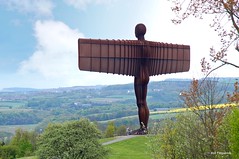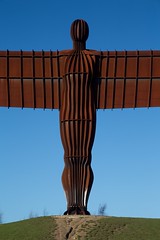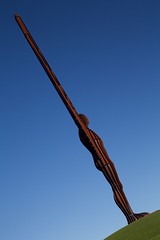Angel of the North
The Angel of the North is a contemporary sculpture by Antony Gormley, located in Gateshead, Tyne and Wear, England. Completed in 1998, it is believed to be the largest sculpture of an angel in the world and is viewed by an estimated 33 million people every year due to its proximity to the A1 and A167 roads and the East Coast Main Line. The design of the Angel, like many of Gormley's works, is based on Gormley's own body. The COR-TEN weathering steel material gives the sculpture its distinctive rusty, oxidised colour. It stands tall with a wingspan of , larger than that of a Boeing 757 aircraft. The vertical ribs on its body and wings act as an external skeleton which direct oncoming wind to the sculpture's foundations, allowing it to withstand wind speeds of over .
The sculpture was commissioned and delivered by Gateshead Council who approached Gormley to be the sculptor. Although initially reluctant, Gormley agreed to undertake the project after visiting and being inspired by the Angel's proposed site, a former colliery overlooking the varied topography of the Tyne and Wear Lowlands National Character Area.
Hartlepool Steel Fabrications were responsible for the manufacture and assembly of the 208-tonne sculpture. On 14 February 1998, the Angel was transported overnight to the installation site and erected the next morning. The project faced opposition during its design and construction, but is now widely recognised as an iconic example of public art and a symbol of Gateshead and the wider North East region.
History
Prior to the construction of the Angel of the North, the most significant landmarks that signalled travellers' arrival into Tyneside, when travelling from the south, were the bridges that crossed the River Tyne. In 1990, Gateshead Council first conceived of a sculpture to act as a new landmark for the southern approach into Gateshead and Tyneside, standing near the A1 and A167 road interchange. Mike White, the Assistant Director Arts at Gateshead Council from 1989 to 2000, stated that the intention was for the Angel of the North to act as a "millennial image that would be a marker and guardian for our town". The process to commission and deliver a sculpture was led by Gateshead Council's Art in Public Places panel, the Libraries & Arts and Planning & Engineering Departments, and Northern Arts – a regional subdivision of the Arts Council of Great Britain which existed from 1990 to 2002. The Council applied for £45,000 of funding from Northern Arts for the selection of an artist and the delivery of an initial design. Although this was the largest public art project the Council had planned to date, Gateshead had already undergone multiple regeneration projects. In the 1980s the construction of Gateshead International Stadium and the MetroCentre signalled a step forward in urban regeneration, and in 1990 the Gateshead National Garden Festival and Riverside Sculpture Park marked the borough's emerging arts policy. The 1990s also saw the conception of other regional transformation projects including the Baltic Centre for Contemporary Art and Gateshead Millennium Bridge.
The Council's Art in Public Places Panel met three times to decide upon a shortlist of artists to build the new sculpture. They were inspired by Antony Gormley's series of structures called The Case for an Angel which he began creating in 1989. After two years of looking for a suitable candidate, Gormley was ultimately selected. After originally claiming that he did not "do roundabout art", Gormley was inspired after visiting the proposed site of the sculpture, comparing it to a "megalithic burial chamber".
Planning permission for the sculpture was secured in 1995 and Gateshead Council acquired funding of £800,000. £584,000 came from the Arts Council England, £150,000 from the European Regional Development Fund, £45,000 from Northern Arts, plus private sponsorship. Momentum for the sculpture continued into 1996, when a 1:20 maquette of the Angel went on display in Shipley Gallery, and Northern Arts won the Festival for UK Visual Arts Year. A two-year series of educational events were conducted with 30 schools and 1,400 children in the area who built their own small-scale versions of the Angel which later went on display in venues around Gateshead and in Sunderland.
Description
Design
The Angel, like much of Gormley's other work, is based on a cast of his own body. The steel sculpture is 208 tonnes, tall, with wings measuring across. Its sheer size and dominance over the surrounding landscape allows for an artistic impact on a large audience. Its wingspan is often compared to that of a Boeing 757 jet, which is actually smaller. The wings are high at the point where they join the body. It is defined by a rusty, oxidised colour which comes from the COR-TEN weathering steel material which, despite being distinctive, does not contrast harshly with the nearby environment. Inspired by this colour, Gormley had originally intended to call the sculpture The Iron Angel of the North. The wings are angled 3.5 degrees forward to create, according to Gormley, "a sense of embrace". They are regular and symmetrical in shape, which contrast with the asymmetrical body.
The Angel, which weighs 208tonnes, stands on top of a base, which itself rests on a concrete slab thick covering . Due to its exposed location, Gateshead Council's engineering director sought advice from Ove Arup & Partners on how the sculpture could be built to withstand winds of over . Although sculptures are often made out of bronze, Arup determined that the material would not be strong enough for a structure the size of the Angel, and weathering steel was used instead. The sculpture, in contrast to other sculptures including the Statue of Liberty, has no internal skeleton to aid with wind resistance or overall stability. Instead, vertical parallel "ribs" run from the head to the feet of the sculpture which function as an external skeleton, breaking up the strength of oncoming wind and focussing it down to the foundations.
Although the Angel of the North is a static sculpture, it is intended to be viewed from many angles and by travellers who pass by at speed – an average of by road. The Angel of the North was designed to have a life of more than 100 years. It has been claimed that it is Britain's largest sculpture, but other sculptures – including Anish Kapoor's ArcelorMittal ''Orbit'' – also claim the title.
Location
The sculpture stands on a hill at Low Eighton in Lamesley Parish, overlooking the A1 and A167 roads and the East Coast Main Line rail route. It lies within the Tyne and Wear Lowlands National Character Area which contains both urban areas and large stretches of fields. The area is also characterised by variations in topography. The Angel sits on top of one of the more elevated positions of the landscape located near Team Valley, allowing the sculpture to be seen from miles around. In the design brief for the Angel, the designated location was described as "commanding views... from distances of up to 4 kilometres arcing through 100 degrees" with landmarks including Durham Cathedral visible. The Angel was built on land which previously contained the pit head baths of the former Team Colliery, which was in use from the 1720s until the 1960s. The remains of the colliery were removed and earth was piled up into a knoll which the Angel now stands on. Gormley commented on this historic connection, saying "When you think of the mining that was done underneath the site, there is a poetic resonance. Men worked beneath the surface in the dark. Now, in the light, there is a celebration of this industry." The sculpture faces south, facing the traffic travelling north into Gateshead and towards Tyneside. Historically, the nearby valley allowed for a convenient passage into Tyne and Wear from the south. Over time, this evolved into more established modern travel routes. Due to its proximity to the main road and rail line, it is estimated that 33 million people see the Angel every year, including those in the roughly 90,000 vehicles which pass each day. The statue can also been seen from nearby housing estates and commercial areas.
The statue can be accessed by road via the A167 and a nearby car and coach park allows people to stop and view the sculpture up close. It also be reached on foot by a number of footpaths. Accessibility, including sitting on and touching the sculpture, is encouraged. It is flanked on the east and west sides by woodland, which has become more prevalent during the life of the Angel. Since 1998, the appearance of the sculpture has become less open and more secluded due to the growth of trees. The trees were planted intentionally along section of the A1 as part of the former Great North Forest initiative and the original brief for the Angel stated that the sculpture would eventually be characterised by a woodland context. When travelling north by road, the first views of the Angel are partially hidden by trees. Train passengers on the East Coast Main Line, located around to the west, are able to see the statue as they travel past.
Construction and installation
Work began on the project in 1994. Following a competitive tendering process, Hartlepool Steel Fabrications Ltd was chosen to fabricate the Angel. The construction took place in a shed bearing the name 'Hartlepool Erections Group', which Gormley visited most weeks during production. The sculpture was constructed in three parts: the body weighing and two wings each weighing . Foundations containing of concrete form the base of the statue, anchoring it to the rock below. Additionally, the old mine workings under the statue had 100tonnes of grout pumped into them to stabilise the site. The foundations were laid in the autumn of 1996.
Gormley made a number of smaller models of the Angel to refine its design. The last smaller model needed to be perfectly scaled-up to inform the shape of the final full-size sculpture. …
Looking for places related to Angel of the North?
Those are other destinations to find places related to Angel of the North:
- Beamish Museum
- Tyne
- Gateshead Millennium
- Angel of the North
- St James' Park
- High Level
- The Sage Gateshead
- Swan Hunter
- Byker
- Metro Radio Arena
- Segedunum
- Biddick Hall
- Causey Arch
- Centre for Life
- Central Arcade
- Bessie Surtees House
- Church of St Thomas…
- Riverside Ground
- Close Power Station
- MetroCentre
- Benwell Nature Park
- Chilton Moor
- Bede's World
- Moorbank Botanic Ga…
















